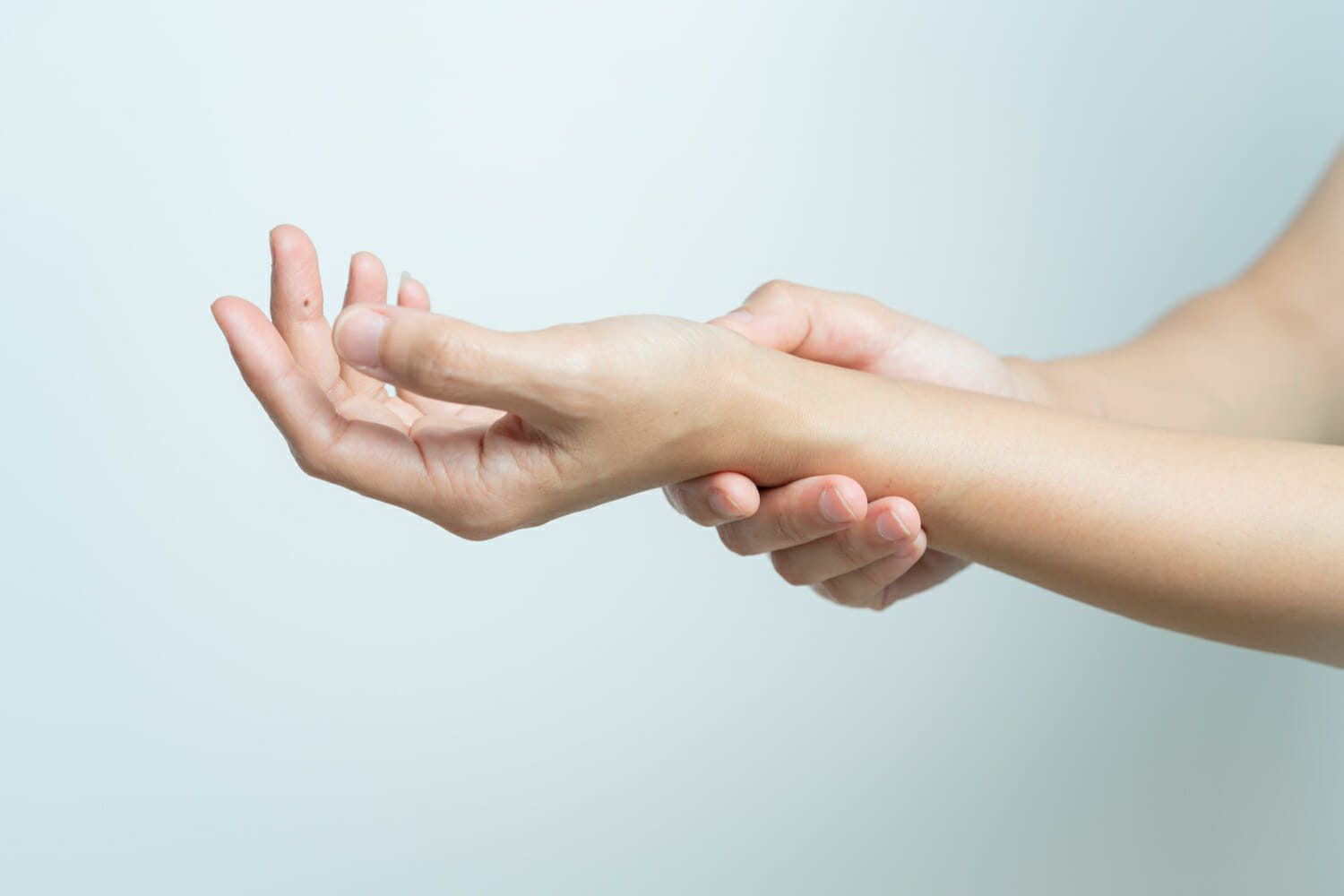Carpal tunnel syndrome (CTS) is a condition that can cause numbness, tingling and pain in your hands and fingers.
Understanding carpal tunnel syndrome
Carpal tunnel syndrome is a treatable condition that can be avoided with the right precautions. Caused by repeated pressure to your median nerve – which runs from your forearm into the carpal tunnel (narrow passageway) in your wrist – CTS has a range of common symptoms. These often include:
- Pain or aching in your fingers, hands or arms
- Numbness or tingling in your hands
- Reduced ability to grip
- Weakened thumb
Typically, CTS symptoms will start slowly and appear irregularly, with certain symptoms feeling worse at night.

Carpal tunnel syndrome risk factors
While some people may be at more risk of getting carpal tunnel syndrome, this does not mean they will go on to develop the condition. It simply means they will need to take precautions to minimise the risk.
Some of the key risk factors associated with carpal tunnel syndrome include:
- Anatomy — any previous fractures or arthritis can change the bone structure in your wrist. This changes the space in your carpal tunnel and can put pressure on your median nerve.
- Your biological sex — being a woman can increase your likelihood of CTS due to the carpal tunnel area being smaller.
- Nerve damage — chronic illnesses like diabetes increase your risk of nerve damage, which can include your median nerve.
- Inflammation — conditions that cause inflammation such as rheumatoid arthritis can impact the lining of your tendons in your wrist and put unnecessary pressure on your median nerve.
- Being overweight — obesity may increase your risk of CTS.
- Office working — incorrect desk setups or insufficient support for your wrists can put pressure on your median nerve during your working day.
- Hobbies that involve using your hands — gaming is an excellent example of this as this is often done at a computer desk which can, again, cause CTS without the right kind of set-up.
Treatment options for carpal tunnel syndrome
Treatment for carpal tunnel syndrome is either surgical or non-surgical. Non-surgical treatments involve making modifications to help relieve your discomfort, while surgical treatments are sometimes required if these modifications fail to make a difference to your symptoms.
Non-surgical treatments
Non-surgical treatments for carpal tunnel syndrome can involve:
- Wearing wrist splints at night to relieve your nighttime symptoms.
- Wearing a wrist brace during the day to offer added support.
- Using nonsteroidal anti-inflammatory drugs (NSAIDs) like ibuprofen to help manage your pain.
- Resting and taking regular breaks from activities that use your wrists, like gaming or typing on a computer keyboard.
- Using physical therapy exercises and stretches to manage your symptoms and relieve some of the pressure.
Surgical treatments
Non-surgical treatments are often enough to treat your carpal tunnel syndrome, but if your condition is more severe then you may need surgical intervention.
A carpal tunnel release is the most effective type of surgery for carpal tunnel syndrome. This can be performed as either an open or minimally invasive procedure and involves cutting the ligament that is putting added pressure on your median nerve.
Endoscopic surgery is used for the minimally invasive version of the procedure. This involves making a small incision in your arm and inserting a small camera into the carpal tunnel. This then allows the ligament to be seen more clearly, making it easier for the surgeon to cut.
During open surgery, the incision will be made in the palm of your hand and your ligament will be cut this way.
After the ligament has been cut, the tissues in your arm will slowly grow back together and provide more room for your median nerve, preventing it from being restricted and causing discomfort.
In most cases, having a carpal tunnel release will not only release the pressure on your median nerve but, once you’ve fully recovered, it should also alleviate any of your other symptoms. You should also notice your hand mobility start to improve over time, with your ability to grip returning.
If your symptoms were extremely severe, however, then even surgery might not eradicate them.
Recovery
After your surgery, you will need to avoid using your hand straight away. Instead, you will need to gradually work your way back to normal by avoiding any forceful movements or wrist positions.
Your hand may feel sore or weak for up to a few months afterwards, but the incision site should heal within a few weeks.
You will also likely need to take time off work to support your recovery, but the length of time you take off will depends on the type of work you do.
Risks of surgery
All surgical procedures carry risks with them, and carpal tunnel release is no exception. Some of the potential risks associated with this type of surgery include:
- Incision site infections
- Scarring
- Injuries to surrounding nerves or blood vessels
- Incomplete release of the ligament
Prevention strategies for carpal tunnel syndrome
Preventing carpal tunnel syndrome is key and you can do this by prioritising your health in everyday situations.
Some of the best tips to take on board are:
- Take frequent breaks from activities that involve using your hands
- Invest in a proper workstation set up with ergonomic accessories
- Sit with the correct posture when at a table or desk
- Incorporate strengthening and stretching exercises for your hands and wrists into your daily routine
- Make different micro-movements when performing tasks with repetitive movements
- Keep your hands warm as they can be more prone to stiffness and pain in colder conditions
Carpal tunnel syndrome tips for office workers
If you are an office worker, you may be more at risk of carpal tunnel syndrome if you don’t have a proper workplace setup.
To avoid CTS effectively, you should have cushioned support under your wrists whenever you use your keyboard and mouse, as well as a supportive mouse and keyboard.
Having a good office chair is also important since you will need to be able to comfortably reach your equipment without strain.
Sitting at your desk all day without a break puts immense strain on your wrists and hands, so make sure to stop every so often. Then, when you have these breaks, try stretching your hands and fingers to keep them flexible and ensure any tension can be released.
To perfect your workplace setup, you will need:
- An adjustable chair
- An external keyboard — using your laptop is not good for your wrists
- A wrist rest at the base of your keyboard
- A mouse mat with wrist support and cushioning
- An ergonomic mouse
Carpal tunnel syndrome tips for gamers
Having an ergonomic gaming setup is vital if you like to game in your spare time or professionally.
If you play on a PC, you will need to invest in an ergonomic mouse with a wrist-support mouse mat. You will also need to angle your keyboard so that your wrists are in a neutral position and supported by a cushioned wrist rest.
While it can be hard to stop when you’re gaming, it’s also important to take regular breaks and rest periods to relieve any pressure you’ve built up in your hands and wrists.
Even if you play with a controller on a games console, you will also need to make sure you support your wrist and hands by taking regular breaks.
Stretching and exercising your hands is essential too, and the prayer position stretch can be especially useful. This involves pressing your palms and fingers together with your elbows pointed outwards, and holding it for 30 seconds at a time.
Some other useful stretches can include holding your arm out straight with your palm facing upwards and then gently pulling back on your fingers for 30 seconds on each arm. This should create a slightly uncomfortable sensation that isn’t too painful.
Book your carpal tunnel release with The Horder Centre
Carpal tunnel syndrome is a preventable and treatable condition. But, with certain groups of people at more risk of it than others, actively working to support your hands and wrists is essential.
If home remedies are not working for you, surgery could be the best solution. Procedures like carpal tunnel release can not only help relieve your symptoms but also treat the underlying cause.
Here at The Horder Centre, we perform carpal tunnel release procedures to help our patients get back to doing what they love without pain. If you’d like to find out more, book your carpal tunnel release with us to put your wrist and hand health first.
What makes Horder Healthcare unique
Horder Healthcare is committed to providing the very best quality of care for our patients and customers. We are continuously working on improving and reducing risks and this is reflected in our consistently high CQC results, patient satisfaction questionnaires and minimal levels of infection.
We are a charity
We reinvest our profit to benefit more people and help us achieve our aim of advancing health.






